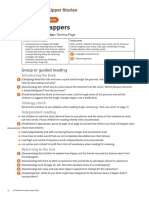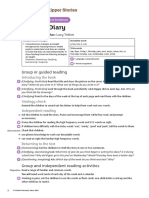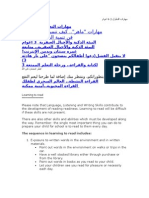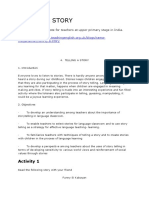Ort BCK Icecream Tns
Ort BCK Icecream Tns
Uploaded by
arjunhdgjCopyright:
Available Formats
Ort BCK Icecream Tns
Ort BCK Icecream Tns
Uploaded by
arjunhdgjOriginal Title
Copyright
Available Formats
Share this document
Did you find this document useful?
Is this content inappropriate?
Copyright:
Available Formats
Ort BCK Icecream Tns
Ort BCK Icecream Tns
Uploaded by
arjunhdgjCopyright:
Available Formats
Oxford Level 1+ More First Sentences C
The Ice Cream
Teaching Notes Author: Gill Howell
Comprehension strategies Decodable words
• Comprehension strategies are taught an, at, big, can, get, on, run, van, yes
throughout the Teaching Notes to
enable pupils to understand what they Tricky words
are reading in books that they can read come, I, ice cream, Kipper, look, no, oh, one, out, splat, that, the, to, want
independently. In these Teaching Notes
the following strategies are taught: = Language comprehension
Prediction, Questioning, Clarifying,
= Word recognition
Summarising, Imagining
Group or guided reading
Introducing the book
(Clarifying, Prediction) Look together at the cover. Ask the children: Who is in the picture? What do
you think might happen in this story?
• Read the title, pointing to the words. Ask: What kind of ice cream do you like?
Look at the pictures in the book to see what happens and encourage the children to find and point to
the words ‘ice cream’ in the text.
• Use some of the words in the chart above as you discuss the story.
(Clarifying) Read the story so that the child can hear it as a rhyme. Ask: What do you notice about
the story? Which words rhyme?
• Read it again and wait for the children to supply the rhyming words.
(Prediction) Ask: What do you think Kipper said to the man on page 8? What do you think the man
said to Kipper?
Strategy check
Remind the children to read from left to right.
Independent reading
• Ask the children to read the story aloud. Praise accurate reading and the use of phonics to read new
words. Prompt them, if necessary.
Check that children:
• notice and talk about the words that rhyme
• use comprehension skills to work out what is happening in the story.
Returning to the text
(Questioning, Clarifying) Check children’s understanding and clarify any misunderstandings by asking
a variety of questions that require recall, inference and deduction such as: Where are the children in
the story? What kind of ice cream did Kipper buy? What happened to Kipper near the end?
Ask the children to find the words ‘ice cream’ in the text (pages 1 and 2).
(Summarising) Ask children to retell the story in two or three sentences.
1 © Oxford University Press 2014
Group and independent reading activities
Read simple words by sounding out and blending from left to right.
Find ‘can’ on page 1. Model segmenting it into phonemes in order and then blending them to read
the word. Ask the children to find ‘can’ again on this page. Together, say each sound separately. Cover
the ‘c’ in the first ‘can’, so only ‘an’ is showing. Ask: Which two sounds do these two letters make?
Find the word ‘an’ on this page.
Can the children show you how to read ‘get’ by sounding the letters?
Link sounds to letters, naming and sounding the letters.
Find ‘big’ on page 4. Model segmenting it into phonemes and blending them to read the word. Ask
everyone to say the three sounds. Talk about the beginning and ending sounds. Ask: What does the
word begin with? What does it end with?
Can the children match the sounds of ‘b’ and ‘g’ to their letter names?
Read a range of familiar and common words independently.
Ask the children to find ‘run’ on page 2. How did they know which word it was? Talk about the
strategy used. If necessary, model segmenting it into phonemes (r–u–n) and matching the phonemes
with the letters on the page.
Can the children find the word ‘van’ on the same page and read it using the same strategy?
Show an understanding of story elements, e.g. sequence of events, openings. Retell narratives in the
correct sequence, drawing on language patterns of stories.
(Questioning) Ask questions to help children recall the sequence of events, such as: What did Kipper
want at the start of the story? What did he do? What happened then? What happened to him in the
end? Read the story again, asking the children to listen for words that rhyme. Write ‘that’ and ‘splat’.
Can the children retell the story using the rhyming words?
Speaking, listening and drama activities
Use talk to organise, sequence and clarify thinking, ideas, feelings and events.
• Together, think of questions to ask Kipper, e.g. What kind of ice cream do you like?, What made you
trip over?, Were you worried when you saw what happened to the ice cream?
• Demonstrate how to react in role by pretending to be Kipper yourself. Invite the children to ask
you questions.
Writing activities
Attempt writing for various purposes.
• Ask the children about the sorts of ice creams that they like.
• Talk about flavours and words for ‘cold’. Put them together, e.g. ‘lemon snow’. Talk about what this
ice cream would look like.
(Imagining) Ask the children to think of an ice cream they would like to eat. Allow them to draw this
and then invent a name for their own ice cream.
Do the children attempt to write names for the new ice creams?
For teachers
Helping you with free eBooks, inspirational
resources, advice and support
For parents
Helping your child’s learning
with free eBooks, essential
tips and fun activities
www.oxfordowl.co.uk
2 © Oxford University Press 2014
You might also like
- ASA Language Year 6 2019 FREEDocument100 pagesASA Language Year 6 2019 FREEAlfred DengNo ratings yet
- Kipper's LacesDocument2 pagesKipper's LacesThuy NguyenNo ratings yet
- Ort BCK Hideseek TnsDocument3 pagesOrt BCK Hideseek TnsMai HamoudaNo ratings yet
- Ort BCK Lostkey TnsDocument3 pagesOrt BCK Lostkey Tnsja7025No ratings yet
- Miau222223Document3 pagesMiau222223Tiberiu PopaNo ratings yet
- Ort BCK Atschool TnsDocument2 pagesOrt BCK Atschool TnsSophia AdamNo ratings yet
- Ort BCK Goawayfloppy TnsDocument3 pagesOrt BCK Goawayfloppy Tnskda.maryam.javaidNo ratings yet
- The Box of Treasure: Group or Guided ReadingDocument3 pagesThe Box of Treasure: Group or Guided ReadingEryNo ratings yet
- Ort BCK Newtrainers TnsDocument2 pagesOrt BCK Newtrainers Tnseyfs.2023No ratings yet
- ort_bck_kidnappers_tnsDocument3 pagesort_bck_kidnappers_tnsiaz96145No ratings yet
- Ort BCK Brokenroof Tns PDFDocument3 pagesOrt BCK Brokenroof Tns PDFSobia KeswaniNo ratings yet
- ShoppingDocument3 pagesShoppingThuy NguyenNo ratings yet
- Spots!Document2 pagesSpots!Thuy NguyenNo ratings yet
- Ort BCK Prsntsdad TnsDocument2 pagesOrt BCK Prsntsdad Tnsdamaris.dobreNo ratings yet
- A New Dog ORTDocument2 pagesA New Dog ORTeyfs.2023No ratings yet
- Ort BCK Stream TnsDocument2 pagesOrt BCK Stream TnsAlmira AslamNo ratings yet
- Ort BCK Rainbowmach TnsDocument3 pagesOrt BCK Rainbowmach Tnsanil kumarNo ratings yet
- ort_bck_play_tnsDocument2 pagesort_bck_play_tnsahmadsubhanidogerNo ratings yet
- The BarbecueDocument2 pagesThe BarbecueThuy NguyenNo ratings yet
- Ort BCK Dinosaurs TnsDocument3 pagesOrt BCK Dinosaurs TnsAroobaNo ratings yet
- The LibraryDocument2 pagesThe LibraryThuy NguyenNo ratings yet
- The HaircutDocument2 pagesThe HaircutThuy NguyenNo ratings yet
- The Egg Hunt: Group or Guided ReadingDocument3 pagesThe Egg Hunt: Group or Guided ReadingIrsa Shaheen100% (1)
- Fun at The BeachDocument2 pagesFun at The BeachThuy NguyenNo ratings yet
- Ort Bck Daylondon TnsDocument3 pagesOrt Bck Daylondon Tnsafshanaamir103No ratings yet
- Ort BCK Laughprincess TnsDocument3 pagesOrt BCK Laughprincess TnsunwantedadvertisementNo ratings yet
- The Lost TeddyDocument2 pagesThe Lost TeddyThuy NguyenNo ratings yet
- ort_bck_newhouse_tnsDocument2 pagesort_bck_newhouse_tnsahmadsubhanidogerNo ratings yet
- The Flying Carpet: Group or Guided ReadingDocument3 pagesThe Flying Carpet: Group or Guided ReadingMisbahSakraniNo ratings yet
- The Dragon DanceDocument2 pagesThe Dragon DanceDobre EsteraNo ratings yet
- ORT Teacher NoteDocument2 pagesORT Teacher NoteSophia AdamNo ratings yet
- ort_bck_storm_tnsDocument2 pagesort_bck_storm_tnsahmadsubhanidogerNo ratings yet
- Ort BCK Secretroom TnsDocument2 pagesOrt BCK Secretroom TnsAbeeha FatimaNo ratings yet
- Ort BCK Submarine TnsDocument3 pagesOrt BCK Submarine TnsMuhammad Mudassar JavedNo ratings yet
- Ort BCK Gran TnsDocument2 pagesOrt BCK Gran TnsRice BuoiNo ratings yet
- Decode Teaching Notes st5Document12 pagesDecode Teaching Notes st5Jiang TaoNo ratings yet
- Ort BCK Redplanet TnsDocument3 pagesOrt BCK Redplanet Tnshashimsaud880No ratings yet
- ORT Nobody Wanted To PlayDocument3 pagesORT Nobody Wanted To PlayBatool FatimaNo ratings yet
- Ort BCK Castle TnsDocument2 pagesOrt BCK Castle Tnsgavin.macmillanNo ratings yet
- Ort FP Fic Zip TnsDocument5 pagesOrt FP Fic Zip TnsMaha GaberNo ratings yet
- Ort BCK Redsblues TnsDocument2 pagesOrt BCK Redsblues TnsSophia AdamNo ratings yet
- Rif Read Aloud Tips GuideDocument18 pagesRif Read Aloud Tips Guideapi-538953209No ratings yet
- Tutoring Strategies For Preschool and KindergartenDocument11 pagesTutoring Strategies For Preschool and KindergartenKarrie Mae GolilaoNo ratings yet
- 3 and 4 Year Old SequnceDocument73 pages3 and 4 Year Old Sequnceibrahim100% (3)
- L11 - Baby Farm AnimalsDocument6 pagesL11 - Baby Farm AnimalsRAAM MECHNo ratings yet
- Ort Ttales Beautybeast TnsDocument4 pagesOrt Ttales Beautybeast Tnsyifan hanNo ratings yet
- MTB MleDocument51 pagesMTB MleLeah B. ZamoraNo ratings yet
- Fly AwayDocument3 pagesFly Awaymickyho569No ratings yet
- Ort BCK Victorian TnsDocument3 pagesOrt BCK Victorian TnsTalal GhouriNo ratings yet
- Tools and Animals Teachers NotesDocument5 pagesTools and Animals Teachers NotesLinda WangNo ratings yet
- How We See Teachers NotesDocument5 pagesHow We See Teachers NotesLinda WangNo ratings yet
- Communication Milestones 4 To 5 YearsDocument2 pagesCommunication Milestones 4 To 5 YearsAya AbouseifNo ratings yet
- Tree Town Teachers NotesDocument5 pagesTree Town Teachers NotesLinda WangNo ratings yet
- Wonderful Me Lesson Plan and ActivitiesDocument75 pagesWonderful Me Lesson Plan and ActivitiesPhạm DuyNo ratings yet
- Introducing and Using The Dialogic Reading Method: Pearson Family Book NightsDocument3 pagesIntroducing and Using The Dialogic Reading Method: Pearson Family Book NightsMyraChNo ratings yet
- Telling A Story: This Is A Module I Wrote For Teachers at Upper Primary Stage in India. SourceDocument13 pagesTelling A Story: This Is A Module I Wrote For Teachers at Upper Primary Stage in India. SourceYogita Bhamare100% (1)
- LGA Tutorial Task EditedDocument14 pagesLGA Tutorial Task EditedRuba Tarshne :)No ratings yet
- How We Learn With Our Five Senses - Unit PlanningDocument10 pagesHow We Learn With Our Five Senses - Unit Planningelizabethbouma100% (1)
- Ort DD Bigbadsnake TnsDocument5 pagesOrt DD Bigbadsnake TnsSmith ChelseaNo ratings yet
- How Can I Help You Teachers NotesDocument5 pagesHow Can I Help You Teachers NotesLinda WangNo ratings yet
- Purpose of WritingDocument13 pagesPurpose of WritingPrabhkeert MalhotraNo ratings yet
- The Moroccan Linguistic SituationDocument6 pagesThe Moroccan Linguistic SituationLop LopmanNo ratings yet
- APCFSSDocument2 pagesAPCFSSswetysri92No ratings yet
- Translating English Humor Into Chinese Subtitles A Semiotic PerspectiveDocument18 pagesTranslating English Humor Into Chinese Subtitles A Semiotic Perspective王晗No ratings yet
- LP Week 8 Form 4Document2 pagesLP Week 8 Form 4yayaNo ratings yet
- Countable and Uncountable NounsDocument9 pagesCountable and Uncountable NounsNathaliaSantillandelRosillo100% (1)
- Intermedio 5 ExamDocument7 pagesIntermedio 5 ExamIvan ARNo ratings yet
- ĐỀ ÔN TẬP GIỮA KÌ 1 LỚP 6Document4 pagesĐỀ ÔN TẬP GIỮA KÌ 1 LỚP 6ann15172004No ratings yet
- PronounDocument10 pagesPronounGaurav GuptaNo ratings yet
- Thi Hki Anh 8Document3 pagesThi Hki Anh 8K59 NGUYEN BAO GIANGNo ratings yet
- The Future TenseDocument5 pagesThe Future Tensesisaydagmawi0442No ratings yet
- (FREE PDF Sample) A Language in Space The Story of Israeli Sign Language 1st Edition Irit Meir EbooksDocument84 pages(FREE PDF Sample) A Language in Space The Story of Israeli Sign Language 1st Edition Irit Meir Ebookssethooiorver100% (1)
- 1.1 21. (Textbook) Limiting Adjectives PDFDocument4 pages1.1 21. (Textbook) Limiting Adjectives PDFUDAYAN SHAHNo ratings yet
- RMCP Vol. 14 Num. 4 (2023) : October-December (English Version)Document200 pagesRMCP Vol. 14 Num. 4 (2023) : October-December (English Version)Revista Mexicana de Ciencias PecuariasNo ratings yet
- 527880193-Interchange-2-Teacher-s-Book 2-359Document1 page527880193-Interchange-2-Teacher-s-Book 2-359Luis Fabián Vera NarváezNo ratings yet
- 5 Tenses SummaryDocument2 pages5 Tenses SummaryMarie PragtigeNo ratings yet
- PaSSIVE VOICE 8Document6 pagesPaSSIVE VOICE 8Adelina HasasNo ratings yet
- Trọng Âm E6 (Unit 1-6)Document4 pagesTrọng Âm E6 (Unit 1-6)Dương Nhật Linh ThưNo ratings yet
- Pre Int Unit 14 Students BookDocument8 pagesPre Int Unit 14 Students Bookalligators.muilezels-0kNo ratings yet
- 2B GRAMMAR Present Perfect + For / Since, Present Perfect: ContinuousDocument1 page2B GRAMMAR Present Perfect + For / Since, Present Perfect: ContinuousB Mc67% (3)
- 5 Verb PhrasesDocument1 page5 Verb Phrasesalma romeroNo ratings yet
- CV Format - Shabash Fakibaj - September 2019 PDFDocument2 pagesCV Format - Shabash Fakibaj - September 2019 PDFNiaz MahmudNo ratings yet
- Ejercicio Feedback UD 2 IVAN CAYUELA FUNEZDocument3 pagesEjercicio Feedback UD 2 IVAN CAYUELA FUNEZjose antonio gonzalez villarNo ratings yet
- VOCABULARY and READING 22nd FebruaryDocument4 pagesVOCABULARY and READING 22nd FebruaryMinelaBasicNo ratings yet
- Sociolinguistics - Politeness Strategy Used by Judges and Contestant in Indonesian IdolDocument16 pagesSociolinguistics - Politeness Strategy Used by Judges and Contestant in Indonesian Idoldurmha.channelNo ratings yet
- Soft SkillDocument12 pagesSoft SkillParkhiNo ratings yet
- Adding EmphasisDocument3 pagesAdding EmphasisCesar BarbatoNo ratings yet
- I Cook Soup For My Mum. I Eat Dinner at 6 PMDocument8 pagesI Cook Soup For My Mum. I Eat Dinner at 6 PMLê Thanh Tú UdaNo ratings yet
- TA 9 - ĐỀ CƯƠNG GIỮA KÌ 1-24-25 - PHODocument14 pagesTA 9 - ĐỀ CƯƠNG GIỮA KÌ 1-24-25 - PHOthienngan77No ratings yet

























































































